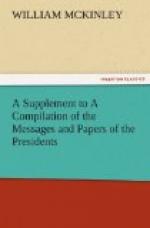Indeed, the only communication had with the Chinese Government related to the occasional delivery or dispatch of a telegram or to the demands of the Tsung-li Yamen for the withdrawal of the legations to the coast under escort. Not only are the protestations of the Chinese Government that it protected and succored the legations positively contradicted, but irresistible proof accumulates that the attacks upon them were made by Imperial troops, regularly uniformed, armed, and officered, belonging to the command of Jung Lu, the Imperial commander in chief. Decrees encouraging the Boxers, organizing them under prominent Imperial officers, provisioning them, and even granting them large sums in the name of the Empress Dowager, are known to exist. Members of the Tsung-li Yamen who counseled protection of the foreigners were beheaded. Even in the distant provinces men suspected of foreign sympathy were put to death, prominent among these being Chang Yen-hoon, formerly Chinese minister in Washington.
With the negotiation of the partial armistice of July 14, a proceeding which was doubtless promoted by the representations of the Chinese envoy in Washington, the way was opened for the conveyance to Mr. Conger of a test message sent by the Secretary of State through the kind offices of Minister Wu Ting-fang. Mr. Conger’s reply, dispatched from Peking on July 18 through the same channel, afforded to the outside world the first tidings that the inmates of the legations were still alive and hoping for succor.
This news stimulated the preparations for a joint relief expedition in numbers sufficient to overcome the resistance which for a month had been organizing between Taku and the capital. Reinforcements sent by all the co-operating Governments were constantly arriving. The United States contingent, hastily assembled from the Philippines or dispatched from this country, amounted to some 5,000 men, under the able command first of the lamented Colonel Liscum and afterwards of General Chaffee.
Toward the end of July the movement began. A severe conflict followed at Tientsin, in which Colonel Liscum was killed. The city was stormed and partly destroyed. Its capture afforded the base of operations from which to make the final advance, which began in the first days of August, the expedition being made up of Japanese, Russian, British, and American troops at the outset.
Another battle was fought and won at Yangtsun. Thereafter the disheartened Chinese troops offered little show of resistance. A few days later the important position of Ho-si-woo was taken. A rapid march brought the united forces to the populous city of Tung Chow, which capitulated without a contest.
On August 14 the capital was reached. After a brief conflict beneath the walls the relief column entered and the legations were saved. The United States soldiers, sailors, and marines, officers and men alike, in those distant climes and unusual surroundings, showed the same valor, discipline, and good conduct and gave proof of the same high degree of intelligence and efficiency which have distinguished them in every emergency.




